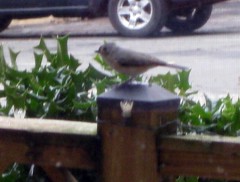But here in East Falls Church, my simple bird-feeder stocked black oil sunflower seed continues to attract a wide range of birds. In fact, a bird showed up last week that I don't think I've ever seen before. When I first saw it, my brain thought "blue jay lite" - blue back, white chest, crested head - but it was way too small and not nearly as shrill. My National Wildlife Federation Field Guide to Birds told me it was a tufted titmouse. (Yes, I keep a bird guide under the window. If the interns at work are going to call me a dorky old man, why not own it?)
 The titmouse crept up on the feeder in a precision assault, picking off one seed at a time, always in the same fashion - from a tree across the parking lot, to my fence post, to the feeder, to the balcony upstairs to eat - pausing for only a moment at each stop to reassess the situation.
The titmouse crept up on the feeder in a precision assault, picking off one seed at a time, always in the same fashion - from a tree across the parking lot, to my fence post, to the feeder, to the balcony upstairs to eat - pausing for only a moment at each stop to reassess the situation.Another first-time visitor showed up the same day: A Carolina chickadee. The bird guide indicated that likely wasn't a coincidence, as the titmouse is known to hang out with other birds, maybe for protection in numbers.
So far, the species I've spotted in just the few months since I started putting out birdseed:
- Tufted Titmouse
- Carolina Chickadee
- Sharp-Shinned Hawk
- Carolina Wren
- Northern Cardinal
- Mourning Dove
- English Sparrow
- European Starling
UPDATE 3/15/2011: The original post referred to the second bird as a black-capped chickadee. However, I told the story to my NWF colleague Doug Inkley, who says it was much more likely a Carolina chickadee. Doug says the two birds look nearly identical, but in this region the black-capped hangs out at higher elevations (like the Appalachian Mountains) while the Carolina is at lower elevations (like Falls Church).

No comments:
Post a Comment